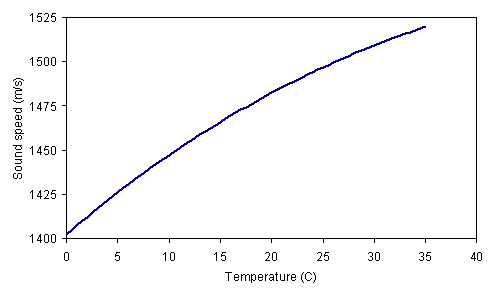Sound speed (c) is dependent on water temperature and salinity, so setting the sound speed requires a priori knowledge of the environmental conditions expected during the survey. Setting an appropriate sound speed is essential, as the selected value will influence bottom depth and range to targets.
In the Great Lakes, sound speeds are between 1400 and 1500 m•s-1 (Fig. 19). Sound speed (c, m•s-1) may be calculated for freshwater using the equation from Del Grosso and Mader (1972):
 |
|
[23] |
where:
T is temperature in ºC.

Figure 19. Effect of temperature on sound speed in freshwater
The sound speed value should be taken from the water column between the transducer and the depth at which the fish of interest are located. As sound speed varies with temperature (Fig. 19), selecting this value in stratified systems should be done consistently and with consideration of the possible biases it may introduce. We suggest using the average temperature of the water column between the transducer and the deeper fish of interest.
Sound speed can be modified in the post-processing software. Sonar5 can adjust for variable sound speed and attenuation with depth if detailed temperature profiles are available.
Absorption (α)
Sound absorption (α, dB•km-1) and acoustic spreading combine for the total acoustical transmission loss. Sound absorption is dependent on the acoustic frequency, water temperature, and salinity. Similar to the sound speed, setting α requires a priori knowledge of the environmental conditions. If significant environmental changes occur, the absorption parameter and sound speed should be recalculated and set for those conditions.
Absorption coefficients can be modified in the post-processing software.